It would perhaps be too much to say that but for the Buddhist faith there would have been no art of sculpture in China. The fact remains, nevertheless, that that art is the direct offspring of the magnificent and richly developed Indian iconography which Buddhism had adopted and adapted as the fitting vehicle for the material expression of its beliefs, and which Buddhist missionaries brought to China in the early centuries of our era.
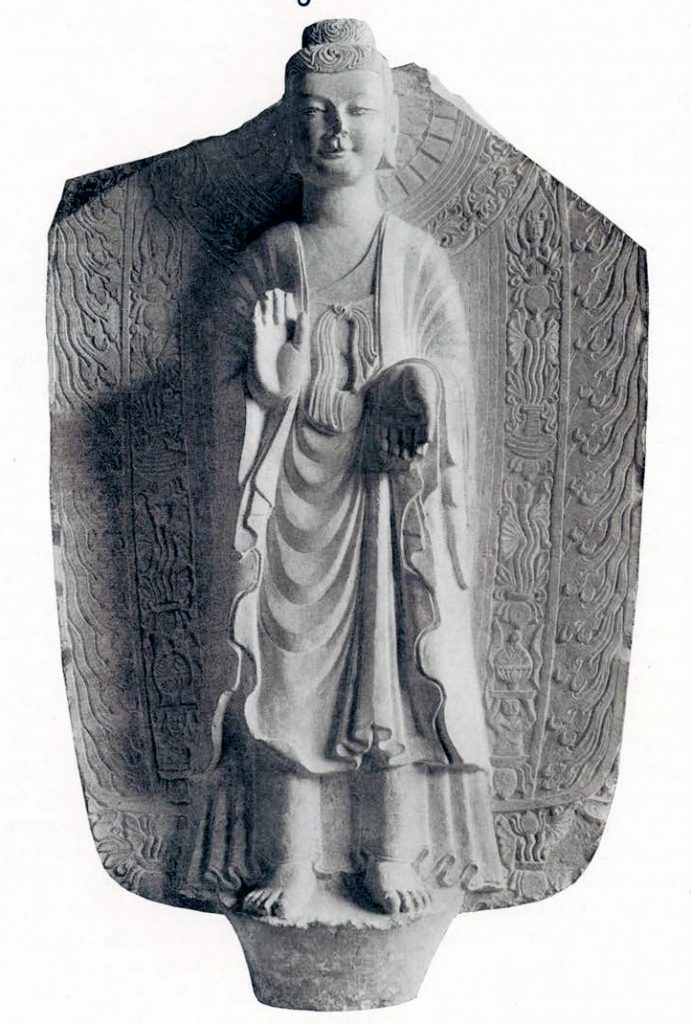
Museum Object Number: C447
Image Number: 1381
Buddhism seems first to have been heard of by the Chinese during the second century B.C., or possibly toward the end of the preceding century. Its official introduction, however, under the imperial patronage, did not occur until the reign of Ming Ti (A.D. 58-76), second emperor of the Eastern, or Latter, Han dynasty. This ruler is reported to have seen in a vision a golden man of supernatural proportions, with a halo, and holding in his hand two arrows. Upon relating his dream, the emperor was informed that the personage could be none other than Fo (Buddha), the great spiritual ruler of the west. The interpretation may have been influenced by the fact that the Chinese ideograph for Buddha is composed of the symbols for “man” and “a bow with two arrows.” Be that as it may, a mission of inquiry was sent to the west, to return a few years later (A.D. 67), bringing back sacred books and images and, more important still, two Buddhist priests to propagate the new faith. A long time was to elapse, however, before any marked effect was produced upon the art of China.
The latter days of the Han were evil, and the dynasty came to a bloody end in A.D. 221. There followed for China a period of four hundred years which are in many ways the saddest in all her history. For a great part of this period the country was divided into a north, under the domination of Tartar conquerors, and a south, ruled by native Chinese princes; but in all sections of the country there was incessant fighting, the setting up of ephemeral dynasties and their overthrow ere they had become established—a period of ceaseless turmoil and bloodshed and terrible suffering on the part of the common people. Nevertheless it was during this epoch that the Buddhist faith spread over practically the whole country, unchecked by the prevailing anarchy, or perhaps even aided by it; for doubtless many an unfortunate was glad to seek refuge in the peace and quiet of the Buddhist monastic establishments.
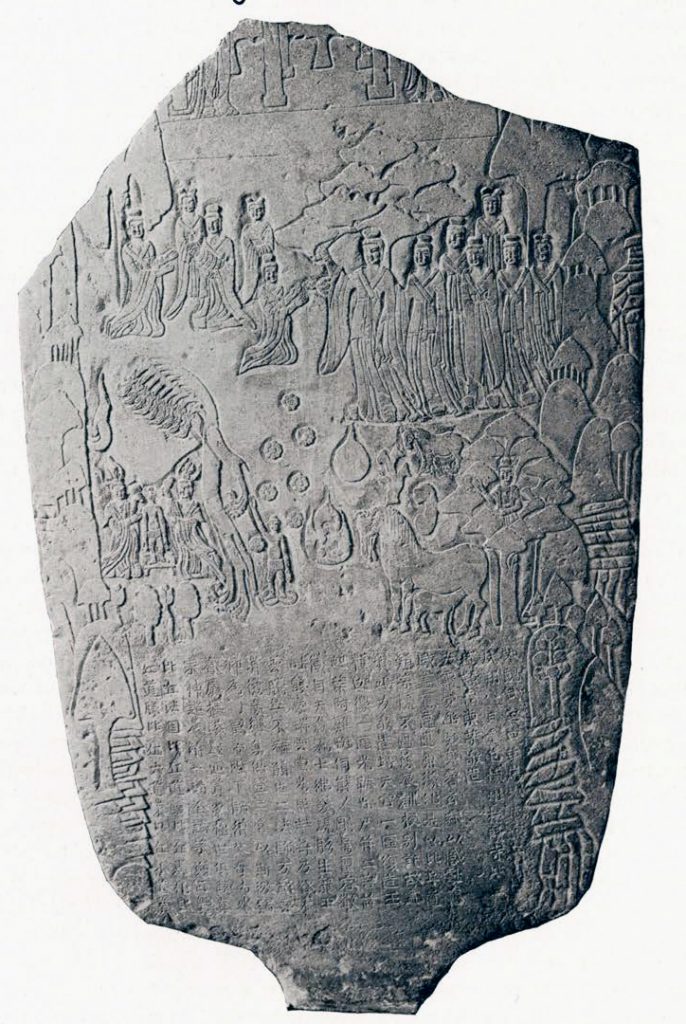
Museum Object Number: C447
Image Number: 1385
No authentic remains of the sculpture of this period have come down to us. We know, however, that stone statues were executed and that work was done in bronze, but that wood, particularly sandalwood, was the material most commonly employed for purposes of sculpture.
Toward the beginning of the fifth century we reach somewhat firmer ground. That commencing about this time colossal works in bronze were executed in China, there is no doubt; but these have long since disappeared utterly, destroyed in the course of the long series of wars and rebellions and foreign invasions to which China has been constantly subject. The statuary in wood, being even more perishable than that of bronze, is likewise lost. Some day, no doubt, scientific excavation of ancient sites will reveal specimens of the lost art of this most interesting period. Until then we must be content to study it through the medium of references in Chinese literature and with the help of a few examples in stone which have survived to the present day.
Before entering upon a discussion of the examples of the Chinese Buddhist statuary of this and later periods now in the possession of the University Museum it may be worth while to attempt a brief outline of the nature and purpose of Buddhist iconography in general.
In the first place, in marked contrast to the dynamic quality so marked in the cognate Hindu art, the art of Buddhism is essentially static in character. The various personages are shown in attitudes indicative of the utmost tranquillity and repose. Most of those figures in Buddhist art which are represented in postures of struggle and stress are Deva kings, wind gods, thunder gods and the like, belonging rather to the realm of folklore than to that of true Buddhist thought.
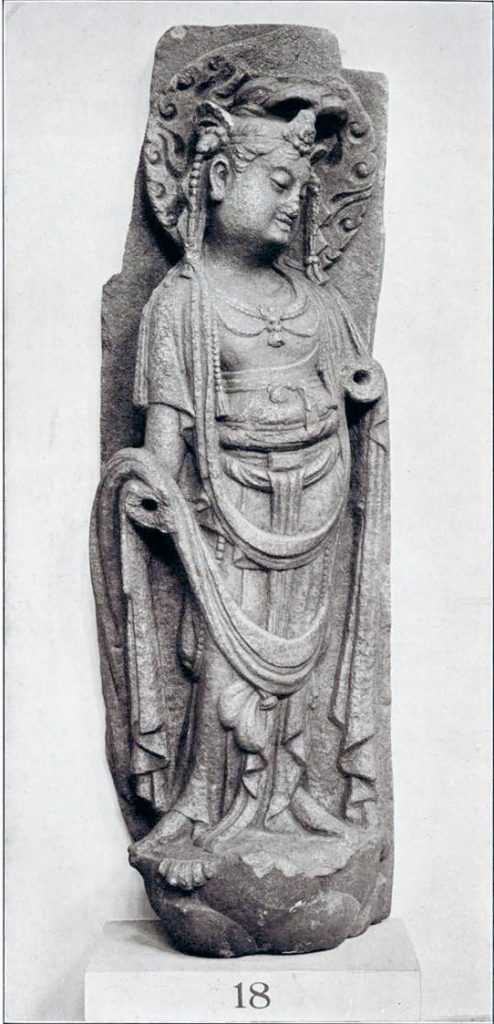
Museum Object Number: C98
Image Number: 1286
Again, it is very rarely that mere physical beauty and bodily strength are exalted. The Buddhist artist looked upon his creations purely as vehicles for the transmission of the truths of a holy and living faith, in which he himself believed with his whole soul. His art was therefore essentially idealistic, mystic, symbolic and transcendental, in marked contrast to the more naturalistic and imitative art to which we of the Occident have grown accustomed.
Another very characteristic trait of the best Buddhist art is the total lack on the part of the artist of any self consciousness, of any striving for glory or reputation. The names of the great masters of Greek art we know; but Buddhist art in its highest manifestations is ever anonymous, for the artist’s personality was sunk in his work, as he hoped that one day it might be sunk and absorbed in the Universal Soul.
Hence it is not fair to judge of Buddhist statuary by standards of artistic excellence alone—least of all by standards based purely on Occidental habits of thought. What we must ask ourselves in each instance is this: Did the statue express to the spiritual consciousness of the people that which the artist meant it to express? To understand the real meaning of Buddhist art, we must try to understand the ideas evoked by it in the mind of the worshiper.
All art is symbolic and interpretative; when it becomes merely a faithful imitation and nothing more it is no longer art. Now Buddhist art is in its very essence interpretative and didactic, making great use of symbolism, often of the utmost beauty. For example, the Goddess of Mercy, the Kwan-yin of the Chinese, is regularly portrayed wearing in her hair or headdress, as the case may be, a tiny image of her spiritual father, Amitâbha, the Buddha of Boundless Light. The idea, of course, is that infinite mercy is the offspring of boundless light or knowledge. To take another example in connection with the same divinity: Kwan-yin is sometimes represented as having a thousand hands, with an eye in the palm of each. The word “thousand” here simply stands for an infinite number, and the thought is that the Goddess of Mercy is reaching out helping hands throughout the universe, each equipped with an eye in the palm to enable it to spy out all suffering and distress.1 The frequent use of the lotus, too, is not without its symbolic meanings, many of them very beautiful indeed; one of them, for example, conveys the message to the believer that just as the flower, though springing from the mire, remains spotless and unsullied, so he himself, if he will, may keep himself equally pure, however sordid and foul his environment.
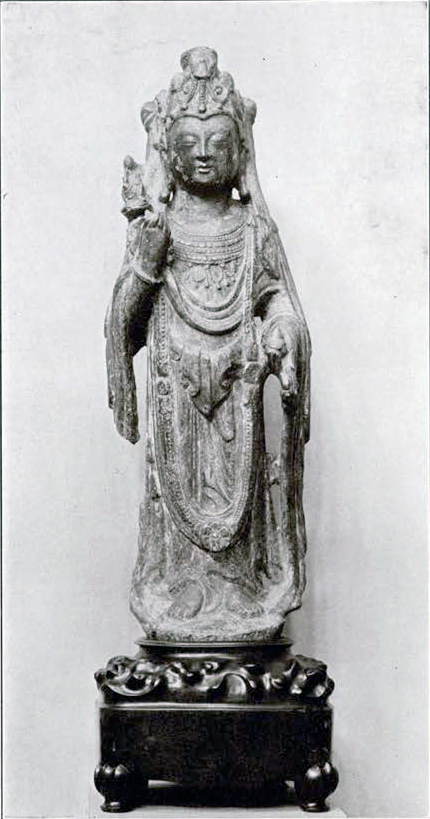
Museum Object Number: C97
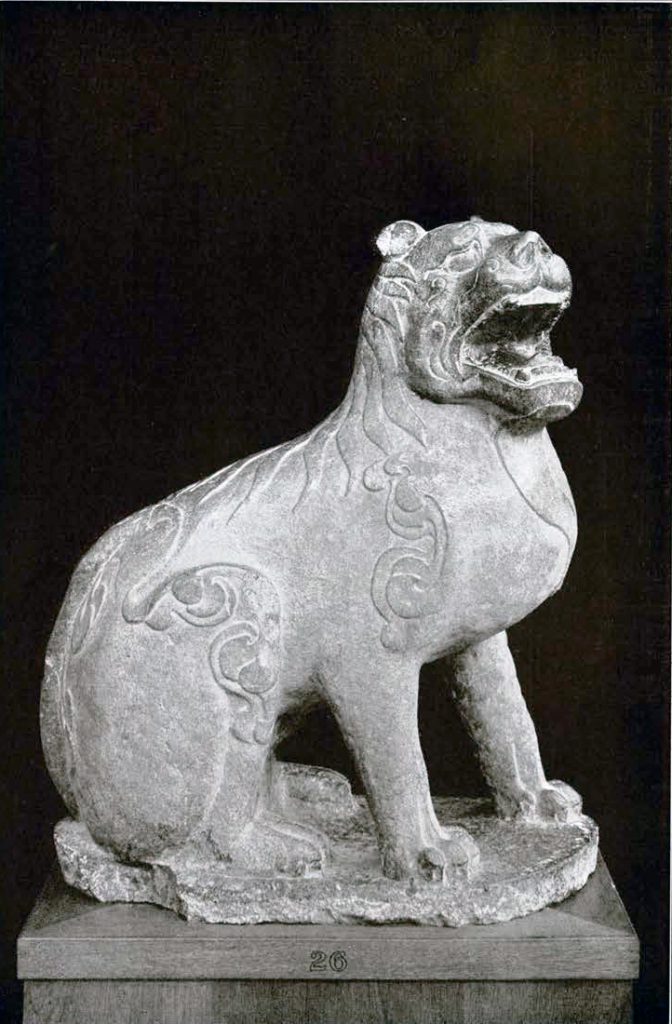
Museum Object Number: C445
Image Number: 1335
To turn now to the examples of Chinese Buddhist statuary in the collections of the University Museum: an exceptionally interesting work, dating from the period of the Northern Wei, a dynasty of Tartar origin ruling in north China A.D. 386-549, is a Buddhist stela (Fig. 160) carved in a very dark hard stone weathered to a light gray through exposure to the dust-laden winds of northern China. That which makes this a work of more than ordinary importance is the fact that it bears upon the reverse a well-authenticated inscription giving the date and place of its origin. The front of the stela is taken up with a statue of the Buddha, about half life size, and in such high relief as to be practically in the half round; while on the other hand the designs upon the background of the statue and the reverse of the stela are in very low relief. The statue was at one time painted in at least three colors. The border of lambent flame around the background was evidently in red, as were also the visible portions of the lining of the drapery. Traces of a deep rich green, possibly in two shades, are still to be seen on the outer garment and also in the floral designs on the background, within the border of flame. It may be, too, that a white or light yellow was used for the mendicant’s cloak, part of the costume of every Buddhist priest from the earliest times, and shown here draped over the figure’s left forearm. There is no indication of pigment upon the hands and face, nor upon the reverse of the monument. Save for the upper part of the stela and the tips of the nose and fingers of the figure, this monument is in practically perfect condition. The mutilation was not accidental, but was the work of some iconoclast, carried out with the aid of a metal tool, the marks of which are still plainly visible, especially upon the nose. The Buddha is represented in the attitude of blessing, and is shown with the ushnîsha or constricted and elevated crown of the head,2 one of the thirty-two lakshanas or signs of auspiciousness supposed to occur upon the person of every Buddha. The ûrna or mark upon the forehead and the long pierced ear lobes so generally characteristic of Buddhist images are not present in this instance. The figure stands with its weight equally upon both feet, and lacks that graceful poise and balance seen in the better examples of later work, while the treatment of the head, hands and feet and the handling of the drapery indicate that the artist was not yet quite master of his craft. The hands, for example, instead of being carved free, are attached by their backs to the body of the statue in rather a primitive way. Nevertheless there is no lack of boldness and certainty and vigor in the workmanship. This is most marked in the treatment of the features, and particularly of the eyes. The photograph does not quite do the sculptor justice in this regard. He evidently knew perfectly well what he wanted to express. If he falls short of his ideal at all, it is due simply to imperfection of techunique and not at all to any lack of spirituality or lofty concept of purpose. In spite of a few slight shortcomings in matters of execution, the statue does not fail to convey to the thoughtful observer that impression of strength and majesty tinged with benignant tenderness always found in the best Buddhist sculpture everywhere.
The designs on the reverse (Fig. 161) consist of scenes from the early life of the Buddha. At the top, to the observer’s right, is depicted the miraculous birth. Mâyâ, the young wife of S’uddhôdana, prince of the S’âkya clan, accompanied by six of her waiting women, stands in the shade of the sacred sâla tree, a bough of which she grasps with her right hand. The infant Buddha appears just issuing from his mother’s right sleeve, to be received in the outstretched arms of a kneeling attendant; the stela here, as in a few other points, differs from the traditional account, which states that the new-born Buddha was received by Indra.3 Signs are said to have accompanied the birth of the Buddha, among them flashes of five-colored light and the appearance of miraculous flowers. It is these, apparently, that the artist has attempted to show in the central portion of the stela, immediately below the birth scene.
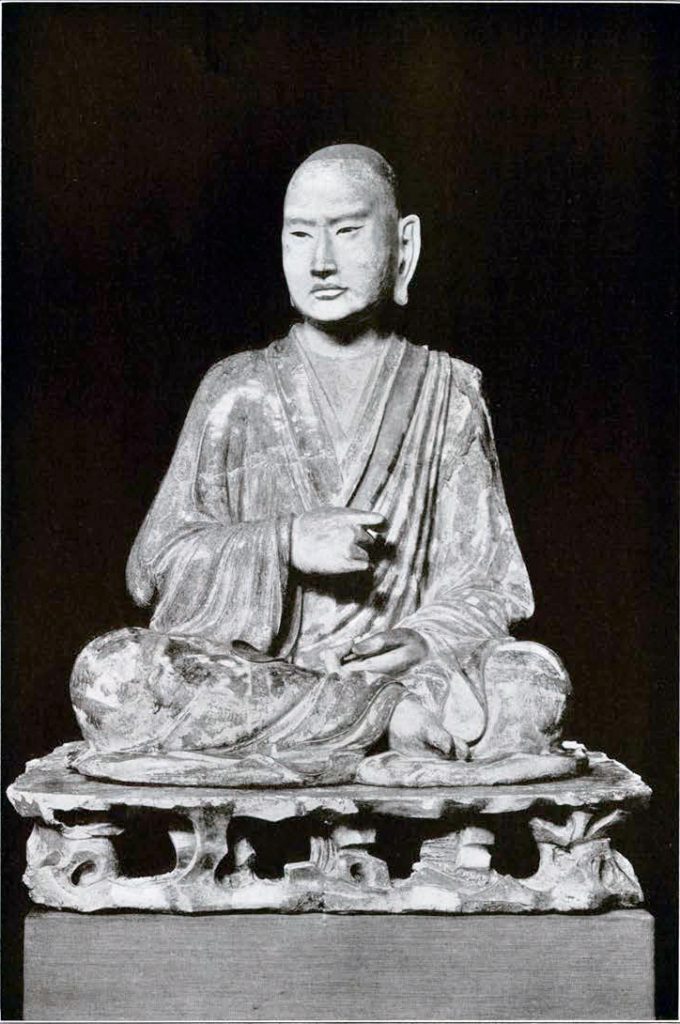
Museum Object Number: C66A
Image Number: 1784, 1594
To the left of the latter, and upon a slightly higher plane, the new-born babe is again shown, tightly wrapped in swaddling clothes, being passed to the arms of another of the waiting women, also kneeling. The next scene, directly beneath this, depicts the baptism (mûrddhâbhichikta) of the young Buddha, who stands upright between two kneeling personages who are sprinkling him with water from long-necked ewers. The traditional account speaks of the Buddha’s baptism as being performed by nine Nâga (serpent spirit) kings. The stela, however, shows but a single dragon, possessing, it is true, nine heads, which curve protestingly over the young Buddha. The treatment of the Nâga is quite typically Chinese, suggesting somewhat the method of depicting the dragon in early indigenous art, save for the multiplicity of heads, which recalls the concept of the many-headed cobra in Indian religious art.
Immediately after his baptism, we are told, “the little babe walked seven steps toward each of the four points of the compass, and pointing with one hand to heaven with the other to earth pronounced with a lion’s voice the following stanza: ‘I have received the body of my very last birth; of all beings in heaven above and under the heaven there is but myself alone to be honored.'” This incident is also portrayed upon the stela, the young child, with right hand pointing zenithward and the left toward the ground, being shown standing close behind the towering figure of the nine-headed dragon king.
The lower portion of the reverse of the stela is occupied by an inscription, of great importance as affording us an idea of the date of the statue. There is no reason to doubt the authenticity of the inscription, which confirms the evidence afforded by the style of the workmanship that this stela is a product of the period, toward the middle of the sixth century A.D., when the empire of the Northern Wei had split into a western and an eastern portion. We are further informed that the stela was made at the Ch’i Hs’ien monastery, in the northwestern part of the present province of Honan.
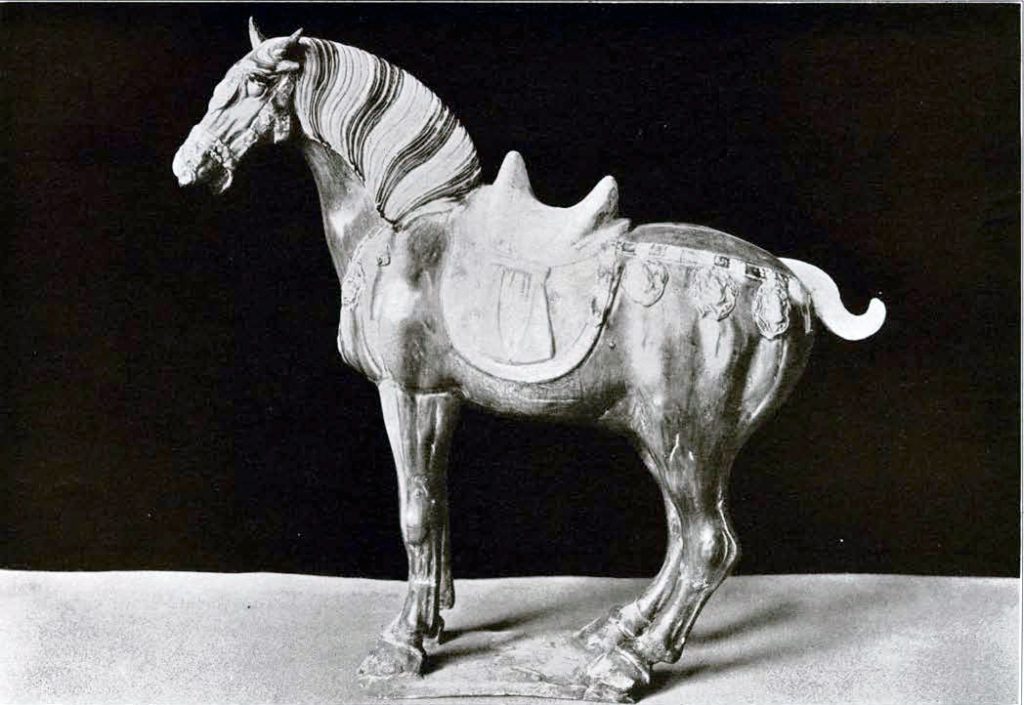
Museum Object Number: C110
Image Number: 10700
Another example of Buddhist sculpture, undated, like most of its class, but attributable to about the same epoch as the preceding, is a statue (Fig. 162) about three feet in height, showing very strong Indian influence. The subject is that of a Bôdhisattva, or being who, through successive rebirths, has at length attained to within one degree of Buddhaship. It is executed in what appears to be the same white magnesian limestone,4 often called marble, from which are carved the colossal figures of men and animals lining the approach to the Ming Tombs north of Peking. The surface has been weathered to a rich, warm brown, and there are faint traces of pigment, indicating a possibility that the statue was originally colored. To all intents and purposes it is in the round; but technically it must be classed as an example of very high relief, as it is not quite fully detached from the slab forming the background. The figure stands upon a lotus pedestal, with the weight resting slightly upon the left foot, while the body from the hips upward is turned in the same direction in a rather graceful pose; behind the head is a halo of lambent flame. The fine features, with eyes almost closed as if in meditation, are expressive of a high degree of spirituality. Exceptionally, for a Buddhist statue, the lobes of the ears are neither of exaggerated length nor are they pierced. Unfortunately both hands are missing; in the stumps are visible the holes for the dowels by which they were formerly attached. The hair is gathered in a large knot, bound about with a fillet, while above the forehead is a jeweled ornament, so badly disfigured that it is difficult to say just what it is intended to represent; it is possible, however, that it is a figure of Amitâbha, in which case we apparently have here a statue of Avalôkitês’vara, later identified, probably not much before the Ming dynasty (A.D. 1368-1644), with the indigenous Chinese divinity, Kwan-yin. Depending from the headgear, just behind the ears, and falling as far as the shoulders, are jeweled pendants, while across the bare bosom is festooned a necklace, richly ornamented. About the waist is a girdle, and a long scarf, looped twice across the front of the body, falls rather gracefully over the right forearm. Upon the whole the work seems too sophisticated to be an original early Chinese concept of a Bôdhisattva. The impression which one receives is that the statue is the work of one of those Indian Buddhist monks who were constantly coming to China during the first five or six centuries of our era; or else that it is a direct copy by a Chinese sculptor of an Indian image, possibly a diminutive one in metal, brought from India by some immigrant priest. It is unfortunate that we know so little at present regarding the provenience of this interesting statue.
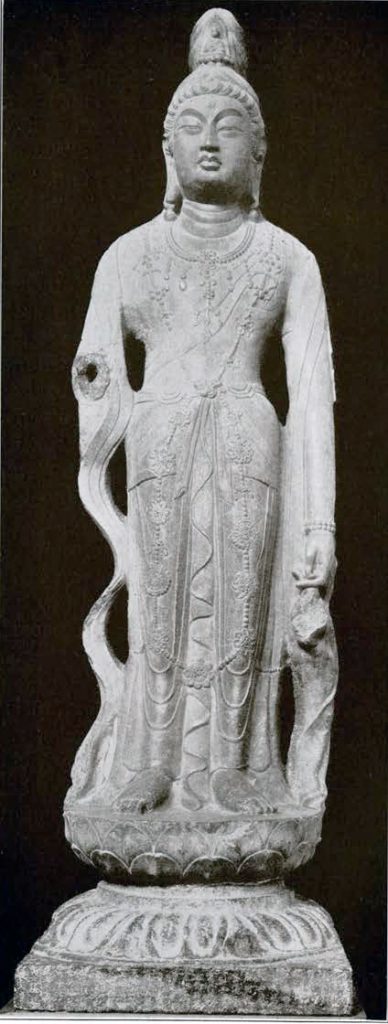
Museum Object Number: C443
Image Number: 1369
The latter half of the sixth century was a period of incessant warfare and kaleidoscopic change of dynasties, most of them of minor importance. At length in A.D. 581 the entire country was reunited under the Sui dynasty, which gave place, in A.D. 618, to the great House of Tang. This line of emperors was founded by a military adventurer named Li-yüan, who, upon ascending the throne which he had won for himself, took the name of Kao Tsu. Under him the land entered upon a period of peace and prosperity such as it had not known for over four hundred years. Both the geographical boundaries and the intellectual horizons of the Chinese people were enormously extended. Contact was reestablished with the civilized lands to the west, and every field of human activity was stimulated to the utmost. What the age of Pericles was to Athens, or the Augustan age to Rome, such to China was the epoch when the emperors of the House of Tang occupied the Dragon Throne.
It was during this period that Buddhist sculpture reached its noblest development. It was no longer felt to be an importation from a foreign land, the product of an alien faith. It had become an integral element of the social consciousness, an intrinsic part of the life of a great period. Henceforth statuary begins to show a degree of naturalism and individuality hitherto unattained, not merely in choice of subjects, but in conception and execution as well.
As is the case with the earlier periods, we know regrettably little concerning statuary in bronze and wood under the Tang. That it was quite as fine as that in stone and clay is clear from the very few remains that have come down to us, principally in Japanese collections. Clay, hitherto employed for small mortuary figures of men, women and animals, now assumed an importance before unknown. One of the very greatest works of fictile art in the world today is a large glazed earthenware statue of a Lo-han or disciple of Buddha, dating from the T’ang period and now on exhibition in the University Museum5 (Fig. 165). The mortuary figure of a horse, from the same period, shown in Fig. 166, was meant simply for interment with the dead, and is no doubt the work of an artisan rather than that of an artist—a copy, it may be at third or fourth hand, rather than an original concept. Yet even here we see exemplified in a high degree the feeling of the age; the modeling is strong and forceful and the proportions are upon the whole very correct. Above all, the spirit and fire of a high-bred horse are amazingly well brought out; although standing still, the animal seems all aquiver to be off, like the arrow from the bow, the moment its master vaults into the saddle.
This same mastery of technique, this ease and assurance in handling materials, are found to a wonderful degree in the stone statuary which has survived from that brilliant epoch. A number of excellent and typical examples of the latter the University Museum has been fortunate enough to acquire, particularly within the past year or two.
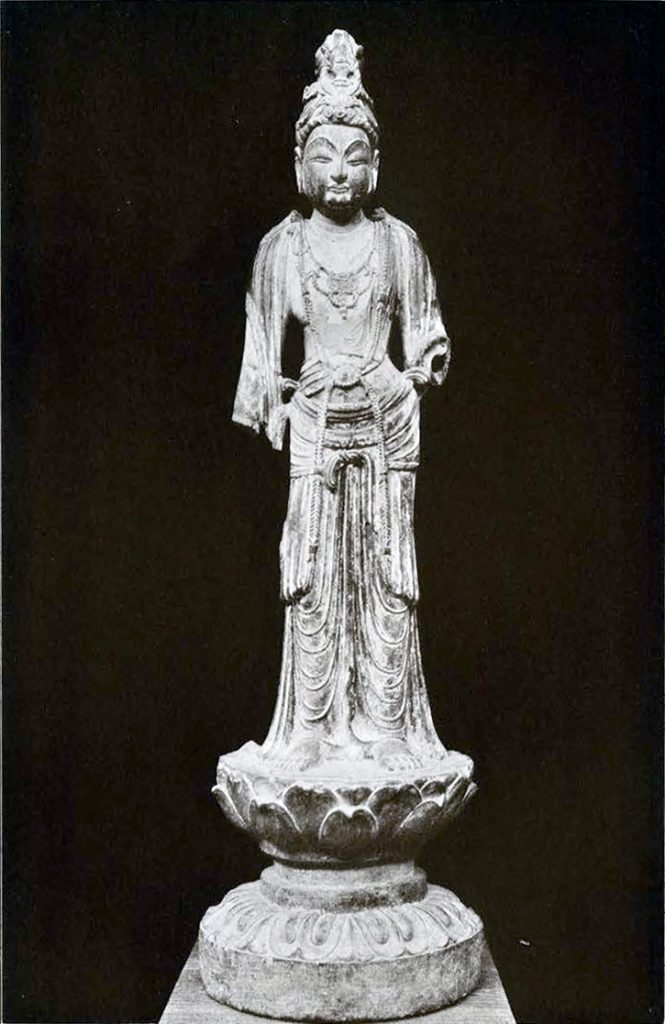
Museum Object Number: C111
Image Number: 1290
One of these is a statue (Fig. 167) of heroic proportions, representing Avalôkitês’vara,6 as indicated by the image of Amitâbha in the headdress. The divinity stands upon a lotus pedestal, clad in gracefully flowing robes and wearing a jeweled headdress, while about the neck and depending down the front of the body are strings of beads and jeweled plaquettes. The ears in this instance, unlike those of the Wei statues described above, are of the characteristic Buddhist type, with greatly elongated lobes decorated with earrings. Save for the loss of the right forearm, the figure is in practically perfect condition. As is so frequently the case, in the stump of the missing forearm is a hole, indicating that the lost member had been carved as a separate piece and then fastened on with a dowel. Between the fingers of the left hand are the remains of what was probably a lotus bud. The well-poised head, with noble, delicately chiseled features, is a marvelous piece of work, comparable with the very best examples of the Buddhist art of this period to be found anywhere. The more it is studied, the more do the merits of this statue impress themselves upon the beholder.
Excellent as this statue is when regarded simply from the point of view of its esthetic merits, it is of even greater importance as bearing undoubtedly authentic inscriptions upon three sides of the square base block. One of these informs us that a certain monk, Cheng Tao by name, who carved this particular inscription, had petitioned the emperor for his portrait and a tablet, for his monastery, and that his request had been graciously granted. The significant part of the inscription is of course the date, which reads: “Twenty-third day of the tenth month of the second year of Shen Lung.” Now Shen Lung is the regnal title of the emperor Chung Tsung, who succeeded to the throne of the T’angs in the year 684, only to be deposed almost immediately by his mother, the Dowager Empress Wu How, one of those tremendously masterful and capable women who more than once in the history of China have possessed themselves of the reins of power. Chung Tsung remained in retirement until his mother’s overthrow in 705, when he was restored to the throne; consequently the date named in our inscription corresponds to the year 706 of our chronology. The remaining epigraphs give merely a number of personal names, without dates, and obviously were cut at a later time.
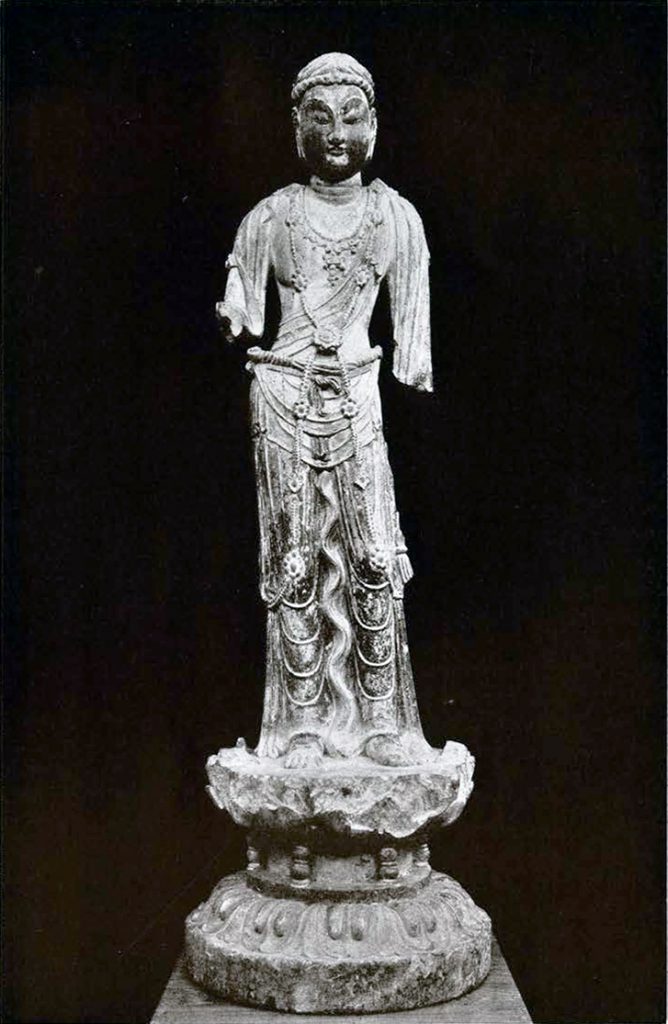
Museum Object Number: C112
Image Number: 1291
Two most charming statues, or rather statuettes, probably from about the same period, are shown in Figs. 168 and 169. These, while not forming a pair in the strict sense, are so similar in feeling and treatment that they might be by the same sculptor. Owing principally to their much smaller size, they have not the majesty and power of the statue just described. But what they lack in this respect they fully make up for by an appealing sweetness and tenderness of aspect and an almost ethereal gracefulness of pose quite indescribable and rarely equaled anywhere.
The one of these statues shown in Fig. 168 is represented as wearing a headdress, which its companion lacks, and its treatment in general is slightly more ornate, the jewelry richer and the costuming more elaborate. The face, too, is rather better, for instead of showing merely the introspective calm so often seen in Buddhist images, it is instinct with life and feeling; its expression, as well as the position of the head, bent graciously forward, show the divinity listening to the supplications of the worshiper and offering him comfort and aid.
In other respects the two statues are singularly alike. Both are almost precisely of the same size, both stand upon lotus pedestals, and both still bear abundant remains of the red, blue, green and yellow paint and gold leaf with which they were once adorned. Even the injuries which they have received are similar, for the forearms of both are lost, as are the long scarves which once fell away gracefully on either side from shoulders to feet, and traces of the ends of which are still to be seen on the surface of the pedestals.
It would be difficult to say with any certainty what particular Bôdhisattvas are represented by these statues. There is no image of Amitâbha borne on the head of either to signify that Avalôkitês’vara is meant. In the case of one the head is quite bare, while in the headdress of the other is represented a chalice-shaped object, presumably the sacred pâtra or begging bowl of the Buddha, about which marvels are told recalling in many ways the cycle of stories clustering around the Holy Grail of Christian legend. Considering the great part played by Avalôkitês’vara in Chinese Buddhism, however, it is generally pretty safe to say that any given statue represents that deity unless there is positive evidence to the contrary, and there appears to be nothing in connection with these two little statues to forbid such an identification.

Museum Object Number: C113
Image Number: 1296
Quite dissimilar in inspiration and execution, but equally great, are another pair of statues, of heroic size, which are believed to have come from the Nan-hsien Tung temple, in Honan. Certain features in connection with these two statues suggest that they are the work of that period, about the middle of the ninth century, when the Buddhist art of sculpture in China reached its culmination. At all events, that they are in the very best T’ang style is certain. There is nothing of the archaic or primitive about them; conception and execution are both of the highest order, and show a thorough sophistication on the part of the sculptor. The faces are particularly fine, evincing a sincerity and nobility and majesty as far removed as can well be imagined from the simpering insipidity of the countenances of so many of the statues of a later day. While belonging to an entirely different province of art, the impression given by the faces of these statues is very nearly the same that one gets from the face of the Lo-han7—an impression of strength of moral purpose and intense concentration upon spiritual things.
One of these statues (Fig. 170) wears in its headdress a little image of Amitâbha, and as in other respects the two are very nearly alike it is probable that both are intended as manifestations of Avalôkitês’vara. In both the left hand is missing, so that we are unable to say just what mental attitude on the part of the divinity its position (mudrâ) symbolized. The jewelry is richer and more minutely worked out, the costuming more elaborate than in any of the preceding examples. Both statues were once painted, for in spite of the long weathering which they have undergone, and which has turned to a deep rich brown much of the surface of the very hard stone from which they are carved, traces of green and blue and red pigment are still visible.
With these two statues may be compared that of a Buddhist priest (Fig. 171) believed to be from the same temple, and similar in many points of technique, but absolutely unlike in inspiration and apparently earlier in point of time. The subject of this statue was not one of those superhuman beings whose representations we have thus far been considering, but a monk, though doubtless one of special reputation for sanctity, or he would hardly have been chosen for immortalization in stone. Though more archaic in some respects, as in the treatment of the drapery, than the two statues just described, and differing from these in proportions, it is very little if at all inferior to these masterpieces as a work of art. The very simplicity of the treatment emphasizes all the more strongly the thing that the sculptor was trying to bring out—the depth of the monk’s abstraction, the intensity of his concentration upon his task of self mastery. Between his hands he reverently holds up, as if for inspiration, a mystic jewel, symbolic of the Sacred Law whose mandates he is striving to follow. His slightly upturned face and his eyes closed to all mundane considerations carry out admirably the thought in the mind of the sculptor. Because of its very humanness this statue has a greater appeal than many another of greater elaboration of detail and facility of technique, but with less purity of inspiration and sincerity and simplicity of expression.
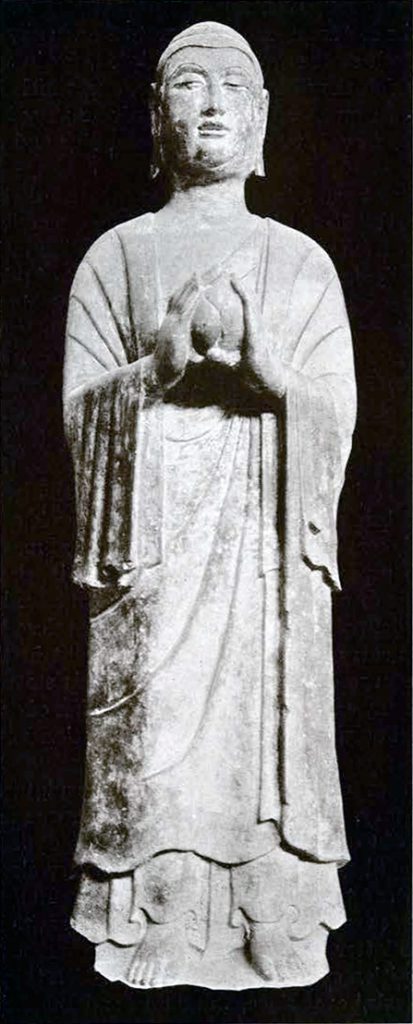
Museum Object Number: C151
Image Number: 1302
Many causes contributed to the decay of sculpture in China after the ninth century. One of the chief of these was undoubtedly the great revival of Confucianism during the Sung dynasty (A.D. 9601280). Enough has been said to show how very closely related was Chinese sculpture to the Buddhist faith. But Buddhism had from the earliest times met with bitter opposition from the Confucianists, and when the latter finally won the victory and secured for themselves that position of influence and power which they have retained, save for intervals,8 ever since, Buddhism and Buddhist art alike fell from their former high estate.
Persecutions of Buddhism there had often been, though these took chiefly the form of attacks upon the conventual system upon which the faith is based, and were not inspired by religious hatred. The matter-of-fact Chinese mind saw no sufficient reason why tens of thousands of able-bodied men and women should be allowed to withdraw themselves from productive secular life, or why millions in money should be taken out of circulation to be cast into images not only of bronze but also of the more precious metals. In general the persecutors contented themselves with destroying the religious foundations, melting down the images of metal, burning those of wood and smashing the ones in stone, and compelling the monks and nuns to return to the world and go to work for a living. In many cases, however, especially where the clergy were suspected of being evil livers, there were appalling slaughters. After a number of minor persecutions in earlier centuries came a great one, under the emperor Wu Tsung (841-847), when 4,600 convents and 40,000 smaller foundations were utterly destroyed and over a quarter of a million men and women compelled to exchange a religious for a secular career. The enormous landed properties of the sect were confiscated to the state, the bronze images and bells were melted down into “cash,” and the gold and silver were turned into the imperial treasury. Immense numbers of Buddhist statues of all sorts must have been destroyed during the course of this persecution, which came just at a time when Buddhist statuary had reached its highest point of development.
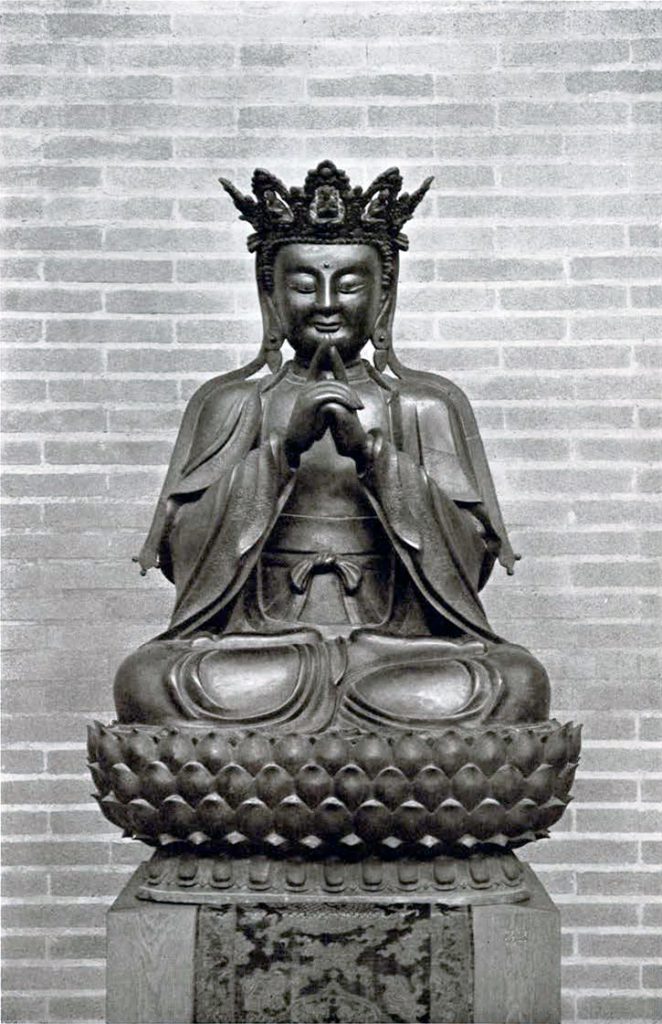
Museum Object Number: C229
Image Number: 1256
Confucianism had not only this directly destructive influence upon Buddhist art, but it also exerted an indirect one of vastly graver effect. During the Tang dynasty the national Chinese character was one of progressiveness and receptivity and eagerness to acquire new ideas and points of view. Confucianism, however, as is well known, is based upon a regard for the past which refuses to allow that any deviation from the ways of the ancients can be aught but injurious and wrong. Consequently with the establishment of the Confucian philosophy as the guiding principle of the state, under the Sung emperors, the national temperament began to lose its elasticity and to crystallize and harden. Progress largely ceased (although by no means so absolutely as is often stated by people who talk about the “unchanging East” with more fluency than knowledge). Successful imitation of ancient masterpieces became the ideal and ambition of the artist. Even statues of Buddhist origin from now on are in general animated, if they can be said to be animated at all, by that devotion to the standards of antiquity which is so prominent a characteristic of Confucianism. Instead of being original creations, they are in most instances mere lifeless copies of the great statuary of Wei and T’ang, which for its part was inspired by a living and vivifying faith in one of the world’s great religions. That Chinese artists of later times have been capable of as great work as ever, as far as technique and the handling of materials are concerned, is shown by such works as the colossal statues, already mentioned, which line the approaches to the Ming Tombs, or the large figures in gilt bronze which have been produced in the past five hundred years. The work on these is often good, the decoration not infrequently fine and the general ornamental effect at times exquisite. It is only lack of originality that causes them to fall short of the highest excellence.
This is well illustrated by a Chinese Buddhist statue (Fig. 172) of the Ming dynasty (1368-1644), of heroic size, which may be regarded as an exceptionally good example of its class. This statue, representing some Buddhist divinity, perhaps Amitâbha,9 is of gilt bronze, much tarnished and worn in the course of centuries, and shows the divinity seated in conventional cross-legged attitude upon a lotus pedestal of the same material. The Buddha wears the crown with the five jeweled peaks, each peak containing a small Buddha figure,10 and the position of his hands tells us that he is in the act of expounding the sacred truths. The flowing garments, which still retain a good deal of their gold plating, are decorated with broad borders of chiseled ornamentation in the way of floral patterns mingled with Buddhist emblems, in the best of taste, while the bosom of the divinity bears outlined upon it a swastika. There is little tangible to criticize in this figure and much to praise. Yet a comparison of it with any of the examples of the great period of Chinese art instantly reveals something wanting. There is no lack of skill on the part of the artist. Probably in matters of technique he had a greater facility than his predecessor of Wei or Yang. Nevertheless his work is wanting in that quality of original inspiration which vitalizes the art of those earlier periods, and which, as this very inadequate sketch of Chinese sculpture has endeavored to show, ranks it with the products of the very greatest schools of art that the world has ever produced.
C.W.B.
1 For a different explanation of this symbolism see the MUSEUM JOURNAL for June, 1914, g. 81.
2 For this and other conventions of Buddhist iconography see the MUSEUM JOURNAL for December, 1914, p. 191 et seq.
3 A very ancient Brahmanical divinity incorporated by the Buddhists in their pantheon on account of his great popularity with the masses.
4De Groot, The Religious System of China, Vol. II, p. 818, note.
5For an account of this wonderful statue, the MUSEUM JOURNAL for September, 1914, may be consulted.
6See ante, p. 154.
7See ante, Fig. 165.
8The chief of these intervals was during the Mongol (Yüan) dynasty, 1280-1368 A.D., when that form of Buddhism known as Lamaism was the state religion.
9 See ante, p. 154.
10 For an explanation of this crown see the MUSEUM JOURNAL for June, 1914, p. 87.

